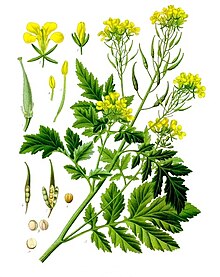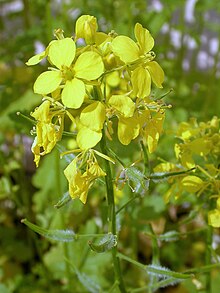White mustard
| White mustard | ||||||||||||
|---|---|---|---|---|---|---|---|---|---|---|---|---|

White mustard ( Sinapis alba ) |
||||||||||||
| Systematics | ||||||||||||
|
||||||||||||
| Scientific name | ||||||||||||
| Sinapis alba | ||||||||||||
| L. |
White mustard ( Sinapis alba ) is a species of the mustard genus ( Sinapis ) within the cruciferous family (Brassicaceae). As a spice plant, it provides one of the basic ingredients of the mustard spice . The term white mustard refers to the white seeds . It is also called yellow mustard because of its yellow flowers .
Mustard contains protein , fatty oils and the glycoside sinalbin (see ingredients ). It tastes hot and hot.
White mustard is an important research object in plant physiology . Numerous insights into photomorphogenesis were obtained, for example, from Hans Mohr and his colleagues at the Biological Institute of the Albert Ludwig University in Freiburg im Breisgau on this plant species.
description
Vegetative characteristics
The white mustard grows as an annual herbaceous plant and can reach heights of up to 120 centimeters. On their angular, branched stems sit well-structured, toothed, coarse hairy leaves. The upper leaves are stalked and pinnately divided to pinnate.
Generative characteristics
The flowering period is from June to July. Numerous flowers are arranged in a loose, umbrella- shaped inflorescence . The hermaphrodite flowers are fourfold. The four free petals are yellow.
The pods protrude horizontally from the stem. The pods have a diameter of about 4 millimeters, are hairy and contain four to eight seeds. The end of the pods forms a flattened beak (= seedless pod part), which is about the same length as the rest of the pod. The beak is often curved like a saber. Overall, the shape of the pod is a good distinguishing feature of this species. The light yellowish seeds are round.
Chromosome number
The number of chromosomes is 2n = 24.
ingredients
The ripe seeds contain around 30% oil and 2 to 2.5% sinalbin . It belongs to the mustard oil glycosides and provides the spiciness in white mustard. Similar to sinigrin , after hydrolysis by the enzyme myrosinase, a pungent-tasting mustard oil - here 4-hydroxybenzyl isothiocyanate - is released.
health
Bisphenol F (BPF) is a chemical compound that is used in plastics . It has also been detected in mustard made from white mustard seeds. The FSVO classifies the health risks of BPF in mustard as low. The laboratory study by the FSVO was able to prove that BPF is formed during the production of the mustard. A contamination of the mustard by the packaging could be excluded. Little is known about the toxicity of BPF, but it appears to be similar to that of BPA . The substance is also considered to be weakly hormone-active . In animal experiments, the weakest daily dose (20 mg / kg body weight) was toxic . A non-toxic dose has not been determined. The average portion size for mustard in Switzerland is around 8 g. The highest concentration of BPF measured in mustard was 8.35 mg / kg. If a person were to consume ten times the average serving , that is, 80 g per day, their intake of BPF would be around 2000 times lower than the animal's toxic dose . Based on the current state of knowledge, the FSVO considers this margin to be sufficiently large to classify the health risks associated with BPF as low. The black and brown mustard seeds that are used to make hot mustards contain no sinalbin and do not form BPF.
Occurrence
White mustard is mainly a crop that is native to the Mediterranean . In Central Europe outside of fields it occurs only inconsistently as a ruderal plant .
Systematics
The first publication of Sinapis alba was in 1753 by Carl von Linné . As a lectotype, Saiyad Masudal Hasan Jafri Herb. Linn. - 845.4. set. Sinapis alba L. is the type species of the genus Sinapis L. synonyms for Sinapis alba L. are: Bonnania officinalis C.Presl , Brassica alba (L.) Rabenh. , Brassica hirta Moench , Eruca alba (L.) Noulet , Leucosinapis alba (L.) Spach , Raphanus albus (L.) Crantz , Rhamphospermum album (L.) Andrz. ex Rchb. Stuckey , Rorippa coloradensis .
The specific epithet alba means white. White here refers to the light color of the seed coat , in contrast to black mustard ( Brassica nigra (L.) WDJKoch , Syn .: Sinapis nigra L. ), which is dark. Both species are listed in Linnés Species Plantarum , 2, 1753, p. 668.
Of Sinapis alba there are subspecies (selection):
- Sinapis alba L. subsp. alba : It comes in Norway , Sweden , Denmark , Ireland , the United Kingdom , Belgium , the Netherlands , Germany , Austria , Poland , Switzerland , Italy , France , Portugal , Spain , Morocco , Croatia , Bulgaria , Albania , Greece , Turkey and the Crimea .
- Slit-leaved white mustard ( Sinapis alba subsp. Dissecta (Lag.) Simonk. ): It occurs in Morocco, Portugal, Spain, France, Italy, Albania, Bulgaria, Crete , Turkey and the Crimea. It is a neophyte in Austria, Hungary and Romania.
- Sinapis alba subsp. mairei (H.Lindb.) Maire : It occurs in Portugal, Spain, France, Italy, Greece, Turkey, Morocco, Algeria , Tunisia , Libya , Egypt , Syria , Cyprus , Israel and Lebanon .
use
The use of ripe seeds for the production of mustard is well known . The leaves are also edible (see below). The plant was already mentioned as a medicinal plant in ancient times, for example by the Greek doctor Pedanios Dioscurides . In folk medicine , freshly ground seeds mixed into a pulp are used externally for compresses .
The green plants are used as animal feed before they bloom. As a fast-growing plant, white mustard is often grown as a green manure. Its widely ramified roots leave a fine crumbly soil.
See also
- Mustard seed (cultural history)
Cultivation
Location
Sunny to partial shade. The weak eater thrives best on humus , calcareous soil . All vegetables are good neighbors , except for other cruciferous vegetables such as cabbage and radish .
Culture and care
Mustard can be sown outdoors in rows 10 to 20 centimeters apart or broadly from March to September. Until the seeds sprout, the soil should be kept moist, but not wet. Care is limited to the necessary watering.
Harvest and recovery
Young plants are cut off just above the ground. The fresh, hot-tasting leaves are added to salads or stews in small quantities. They also season sausage , quark and egg dishes . In Indian cuisine , the mustard herb is used like spinach.
One study found that the leaves (which are part of traditional local Mediterranean diets ) have potential anti- diabetes effects.
White mustard and black mustard are often as groundcovers catch crop sown in late summer, the leaching of nutrients - particularly nitrates - to prevent or reduce. The plants then remain on the field as green manure for humus enrichment and for erosion protection; they are often incorporated.
Pests and diseases
Pests are the earth flea , the black legged and the whitefly .
Individual evidence
- ↑ Several images: Loesels Rauke (city rocket) and white mustard (yellow mustard) in comparison on the website of Bad Vöslau (Lower Austria). ( Memento from May 26, 2013 in the Internet Archive )
- ^ Erich Oberdorfer : Plant-sociological excursion flora for Germany and neighboring areas. 8th edition. Verlag Eugen Ulmer, Stuttgart 2001, ISBN 3-8001-3131-5 . Page 439.
- ↑ Bisphenol F In: admin.ch, May 17, 2017, accessed on November 26, 2017.
- ↑ a b Linné 1753 scanned in at biodiversitylibrary.org .
- ↑ Herbarium from Linnaeus Herb. Linn. - 845.4. at The Linnean Society of London .
- ↑ a b White Mustard at Tropicos.org. Missouri Botanical Garden, St. Louis, accessed October 25, 2015.
- ↑ a b c d Sinapis alba in the Germplasm Resources Information Network (GRIN), USDA , ARS , National Genetic Resources Program. National Germplasm Resources Laboratory, Beltsville, Maryland. Retrieved October 25, 2015.
- ↑ Heinrich Marzell : Dictionary of German plant names. Volume 4: Sabadilla-Zygophyllum. , Verlag S. Hirzel, Stuttgart, 1979, p. 335.
- ↑ Newspaper article mustard: A hot and healthy thing! , Author: Antonia Rose, from August 14, 2017 KREISZEITUNG Böblinger Bote (online)
- ↑ Mustard - seasoning and skin irritants, at www.ptaheute.de: Local medicinal plants in a short portrait
- ^ Heinrich et al .: Understanding local Mediterranean diets: A multidisciplinary pharmacological and ethnobotanical approach. In: Pharmacological Research Volume 52, 2005: (PDF; 967 kB) , last accessed on March 23, 2013
- ^ Heinrich Hofmeister, Eckhard Garve: Lebensraum Acker. Verlag N. Kessel, 2006 ISBN 3-935638-61-2 .
Web links
- Sinapis alba L., white mustard. In: FloraWeb.de.
- Sinapis alba subsp. alba L., white mustard (subspecies). In: FloraWeb.de.
- Sinapis alba subsp. dissecta (Lag.) Bonnier, slit-leaved white mustard. In: FloraWeb.de.
- White mustard . In: BiolFlor, the database of biological-ecological characteristics of the flora of Germany.
- Sinapis alba L. In: Info Flora , the national data and information center for Swiss flora . Retrieved October 24, 2015.
- Distribution in the northern hemisphere according to: Eric Hultén , Magnus Fries: Atlas of North European vascular plants 1986, ISBN 3-87429-263-0 .
- Thomas Meyer: Data sheet with identification key and photos at Flora-de: Flora von Deutschland (old name of the website: Flowers in Swabia ).
- Gerhard Nitter: Profile with photos.
- Günther Blaich: data sheet with photos.





